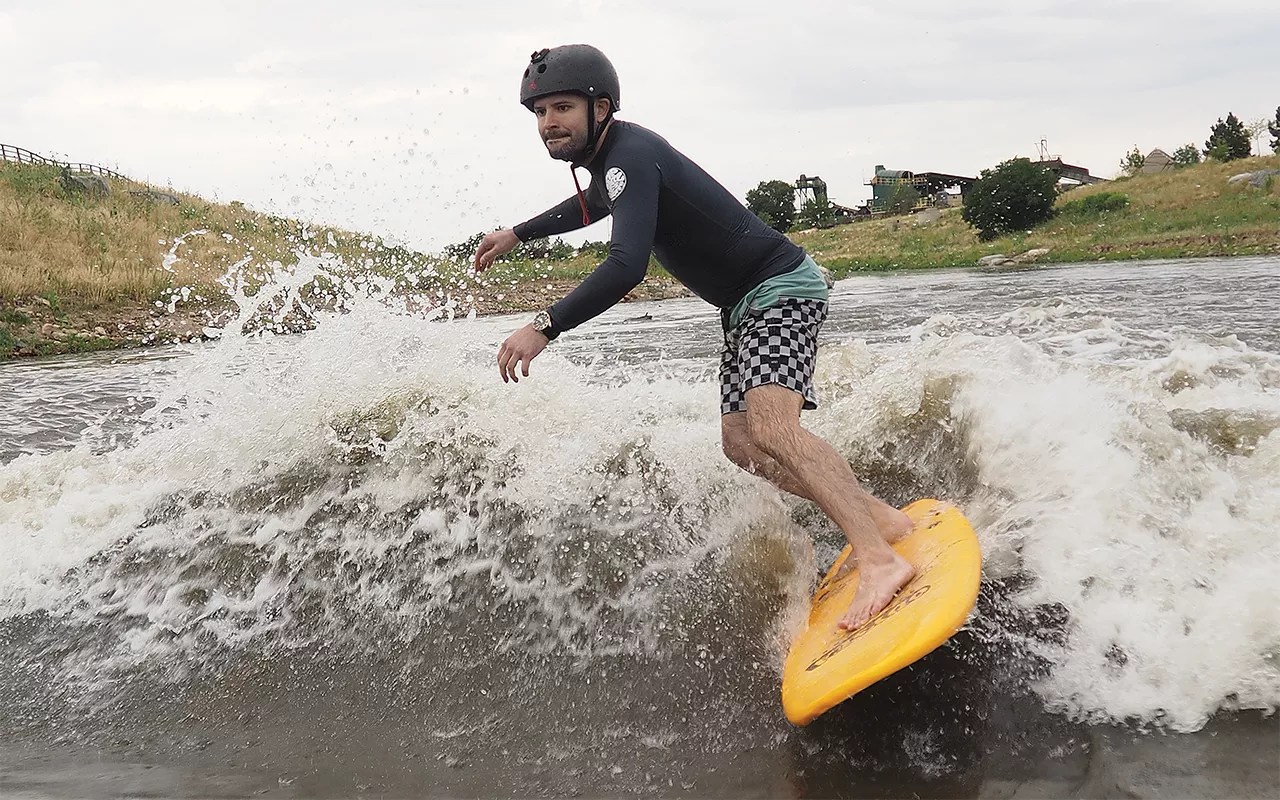
Jay Vollmar

Audio By Carbonatix
On a hot Monday afternoon in early August, more than a dozen surfers are lined up at Sixx, one of three surfable waves at Englewood’s River Run Park on the South Platte. Water flowing at around 350 cubic feet per second has helped to create perfect surfing conditions.
The surfers – some in full wetsuits with helmets and personal flotation devices, others wearing only board shorts – hoot and holler in support of each other as they take turns jumping onto the wave, riding it for anywhere from a few seconds to a few minutes before succumbing to the force of the Platte, then paddling back for more with an assist from the river’s eddy.
There are expert surfers and first-timers in the lineup, men and women, teens and adults well into their fifties. Falls are cheered as loudly as frontside slashing turns on the crest of the wave, and everyone falls, repeatedly. The vibe gets even looser as the sun sets and the sky turns dark. Nathan Ginn and his wife, Carrie, start bomb-dropping into the wave to ride it party-wave style, two at a time.
Ginn has spent his life snowboarding, skateboarding and snowskating, but he’d never surfed before River Run Park opened in 2016, the result of a partnership between the Army Corps of Engineers, the Urban Drainage & Flood Control District and Denver-based McLaughlin Whitewater Design Group to rehabilitate a half-mile stretch of blighted riverway.
“When the water levels are right, it’s just like a powder day: It’s on.”
“When the water levels are right, it’s just like a powder day: It’s on,” Ginn says. “When they first built River Run Park, I went and looked at it and I was hooked. I immediately started trying jumps and spins and other tricks, basically skateboarding on the river. Everyone brings a different style to it, and it’s the most welcoming community I’ve ever been a part of. It’s so much fun.”
Ginn’s skate background shows in his faster, more aggressive style as he carves back and forth across the wave to the concrete edges that help define it, power-sliding on the wave, and doing tricks like varials that spin the board 180 degrees under his feet. He and his friend Matt Kabeiseman recently launched a YouTube channel, The Matt and Nathan Show, to share the stoke of skate-inspired river surfing. The two have been experimenting with different boards made by local shaper Dan Setzke of Colorado Surf Supply, including boards without surf fins, to advance the skate style.
Of the surfable waves at River Run Park, Sixx is the largest and attracts the biggest crowd.
“I’m a big fan of all three waves, though,” Ginn says. “Benihana’s is the most punk-rock, hard-core, rowdy wave because the entry is a little bit hard. You have to jump into it and it’s a skinnier wave, so it has more focused power, and it’s not as smooth and glassy as Sixx. Chiclets is supposed to be the beginner wave, but when the water levels are right and it greens up, it’s super fun and smooth. It’s underrated.”
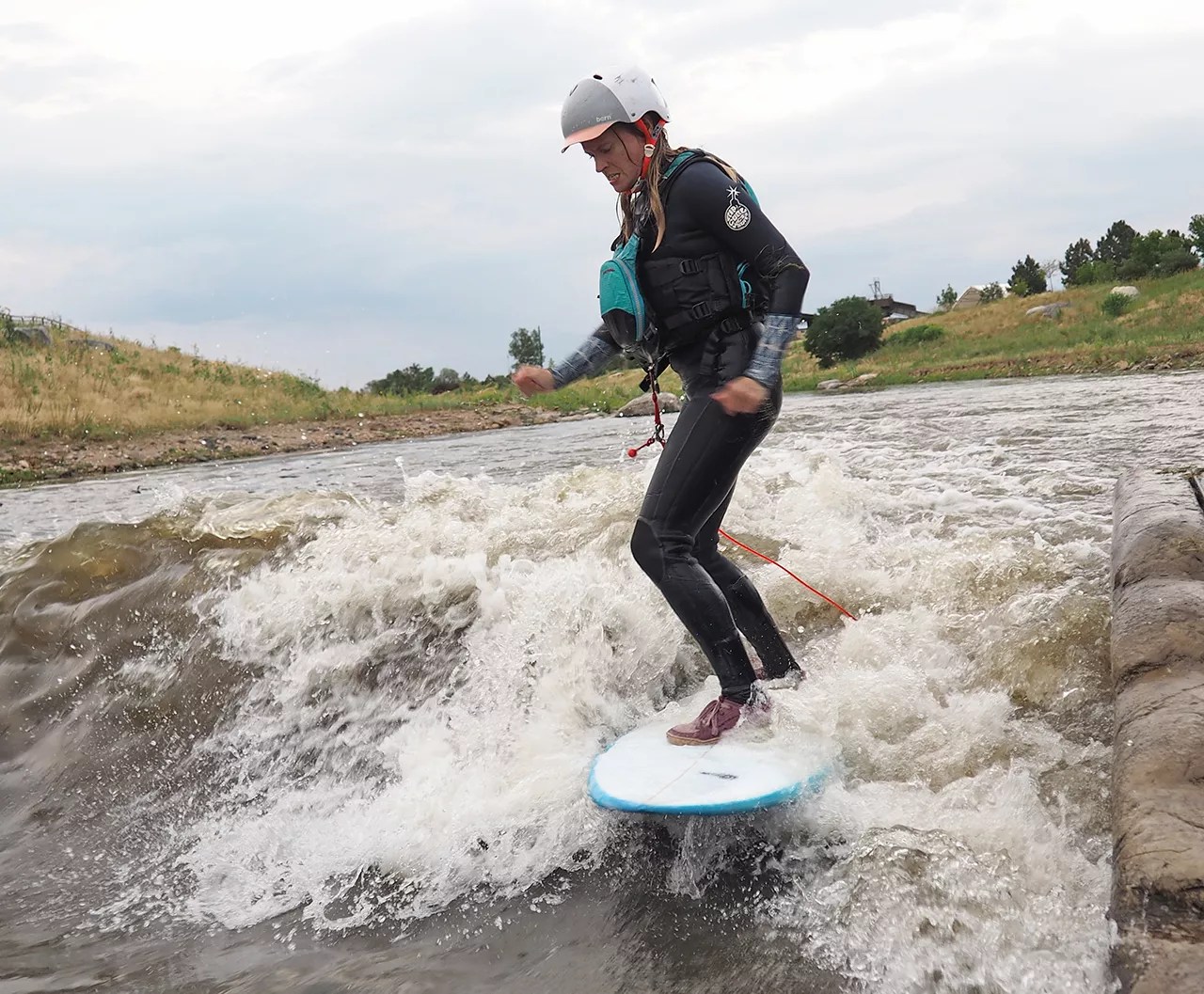
Blair Bear at River Run Park.
Jay Vollmar
A few days after my mostly unsuccessful attempts to surf Sixx, I reach out to Blair, a woman I’d seen surfing well on the wave and who seemed to know a lot about rivers, water safety and safety equipment. She’d even given me several pointers as I was slamming into the water over and over again just trying to jump into the wave, and her advice helped me finally get a few glorious seconds on my feet before everyone called it quits around 9 p.m. on my first night.
“It was pretty intimidating the first time I tried it, too,” says Blair, who’s so widely known as “Blair Bear” in the river-surfing community and in her work at Altitude Paddleboards that she does not use her last name. She came to ocean-style river surfing as a stand-up paddleboarder, and says a lot of her customers looking for river-surfing equipment at Altitude Paddleboards followed the same path.
“I still think we’re seeing the sport in its infancy,” Blair says. “There’s been a lot of growth in all types of recreational water activities in just the last two years, especially river paddling and river surfing. We’re seeing new technologies for standing up a surfable wave, new spots emerging as a result, and some companies starting to do really cool things with board development to make the experience better. And we’re seeing a lot of cities and communities realizing some of the inherent dangers of the aging low-head dams they have in place and wanting to create playgrounds for kayakers and surfers to recreate as they’re in the process of fixing them up and making them safer.”
Blair met her boyfriend, Jeff Matchette, on the river. He’s the treasurer of the Colorado River Surfing Association (CRSA), a nonprofit founded in 2018 to help grow the sport, build community, promote water safety, advocate for conservation projects, and work to protect the health of Colorado’s waterways through river cleanups and river education events.
The couple surfs at several other spots along the South Platte River in addition to River Run Park, and at places in Golden they consider too dangerous for beginner surfers. They also travel to the whitewater parks that have been built in Pueblo, Buena Vista, Salida, Glenwood, Gunnison, Basalt, Eagle, Frisco, Lawson and Del Norte over the last two decades. Originally designed to cater to kayakers and other playboaters, these facilities now attract river surfers, too.
Like any ocean surfers obsessed with tracking swell reports on Surfline.com, or skiers and snowboarders trying to predict powder days on OpenSnow.com, Blair and Matchette now make it a daily habit to check EndlessWaves.net for water-flow reports. The measure that matters is cubic feet per second (CFS): Local kayakers and river surfers know that some naturally surfable river waves start to take shape between 1,500 to 10,000 cubic feet per second. EndlessWaves.net maps more than thirty surfable waves in the state, including natural waves like Charlie’s Hole on the Yampa River near Steamboat Springs and Canyon Doors on the Arkansas River near Nathrop.
The low-flow waves at River Run Park are specially designed to take shape at between 150 to 350 cubic feet per second. For much of July and the first few weeks of August, the water was pumping there at between 250 and 350 CFS, and the surfers were out in force.
“The South Platte is strictly agricultural; the Army Corps of Engineers controls outflow from the dam at Chatfield,” Blair explains. “When they get water calls from farmers downstream, that’s when they release. It has nothing to do with recreation. We just wait for alerts and check the water-flow gauges daily to get a sense of when the surf will be best.”
Blair’s love of river surfing has taken her to waves in inland cities like Boise, Idaho, and Bend, Oregon. She and Matchette have also been working with others in the river-surfing community to champion the construction of new river waves in metro Denver.
“I personally would like to see inland surfing across Colorado and in all landlocked states.”
“I personally would like to see inland surfing across Colorado and in all landlocked states,” Matchette says. “The technology is there, there’s a lot of places it can happen – these waves can go in anywhere there’s a river – and the fact is, there are a lot of places where there are dams that are currently dangerous and need to be replaced, so the opportunity is there.”
Blair has a bigger-picture vision beyond her own desire for surfable river waves. “The more recreational waves they build, the more people are going to become more water-aware, want to help clean up rivers, and be more conscious of what’s going down the storm drains,” she says. “The more we get people to recreate in the river environment, the more people are going to be aware of and take care of that environment.”
On my first night of surfing, I also met local ripper Larry Ward Jr., born and raised in Englewood. He’d never even considered surfing before he and his brother came out to see River Run Park for the first time, and were amazed to find new life along a stretch of the South Platte they’d always known as blighted. The first time he saw surfers on the wave, Ward went home, got on the Internet looking for information, and began constructing his own board. His original design exploded as soon as it hit the water, he recalls, but he’s been determinedly improving his work and is proud that he learned to surf on boards he built.
He also’s also proud that surfers have continued the upkeep around River Run Park: He helped organize the third annual Earth Day River Cleanup, a community event co-hosted by CRSA and South Platte Renew.
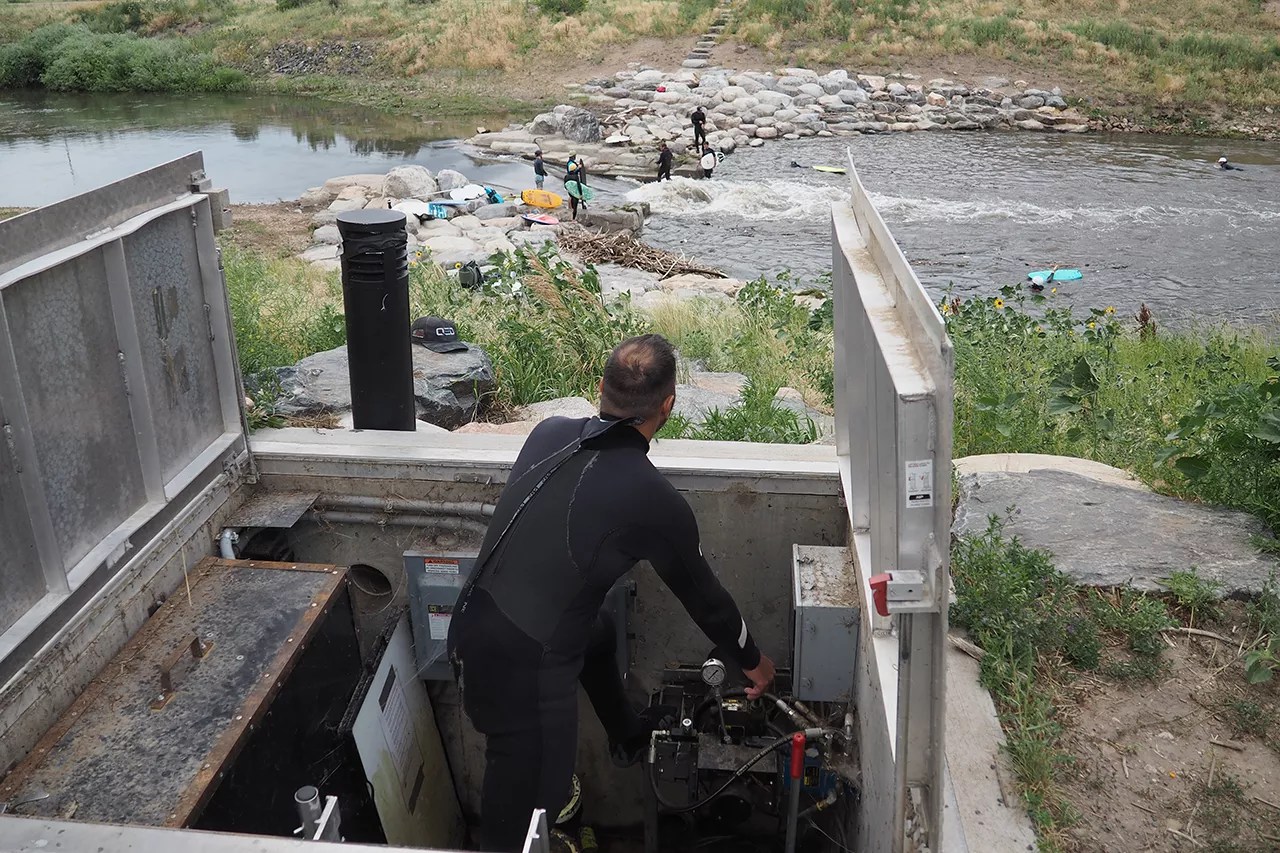
WaveShaper volunteer Adam Tymn makes adjustments at Sixx to make the water smoother.
Jay Vollmar
Rick McLaughlin of McLaughlin Whitewater Design Group developed and patented the adjustable WaveShaper technology used to shape the waves at River Run Park; volunteer “wave masters,” including CRSA members, make minor adjustments to the mechanism to help tailor the shape of the wave depending on the flow rate of the water. On the first night I surfed at Sixx, a volunteer noticed that the wave was creating too much foam – surfers prefer the water looking green and glassy, because it makes for a smoother ride – and clambered up the rocks from the river to a hydraulic mechanism near the bike path, where he made a one-inch micro-adjustment to the WaveShaper mechanism. Surfers below cheered the immediate improvement and went right back to surfing.
The WaveShaper has been used in several other locations, including a wave in Boise that is surfable year-round and a recent project in Columbus, Georgia, but McLaughlin says the River Run Project was groundbreaking because it proved the WaveShaper could create a surfable wave with very low water flow.
“Other surfable river waves require a lot of water, usually somewhere from 1,000 to 2,500 CFS,” McLaughlin says. “At River Run Park, the wave works pretty well starting at about 250 CFS. For the industry, that’s pretty significant. It’s really the only low-flow river-surfing wave of its kind, and it proved we can create something fun in just about any river.”
McLaughlin got his start in multi-use hydraulic engineering projects that incorporate whitewater recreation while working with his mentor, Bill Taggart, whose work at Denver’s Confluence Park created the country’s first urban in-stream whitewater recreation facility in 1974. In the mid-1990s, they worked together on upgrades at Confluence Park, including a series of boat chute drops that are still popular today. Although the features there aren’t ideal for river surfing, they have been popular among inner-tubers, kayakers and stand-up paddleboarders for decades, so much so that some locals refer to them as “the poor man’s Elitch’s”: In the shadow of the Elitch Gardens water park, anyone can inflate an old inner tube and float down the rapids for free.
McLaughlin notes that several of his competitors in the whitewater recreation space shared the same mentor: Before his death in 2008, Bill Taggart also inspired Scott Shipley of Lyons-based S20 Design & Engineering, Gary Lacey of Boulder-based Recreation Engineering & Planning, and Bob Campbell of Glenwood-based Whitewater Parks International. The four Colorado companies are responsible for the engineering of just about every designed whitewater project in the United States.
“My mission is to get people, particularly young folks, out enjoying rivers.”
“Earlier in my career I was designing slalom-type venues for kayaks and canoes, and then by the ’90s, we were designing for freestyle kayaking and playboating,” McLaughlin says. “Now river surfing is increasingly popular. I really like it, because it’s got a low-entry cost, so it’s easy to get into. My mission is to get people, particularly young folks, out enjoying rivers. River surfing has really taken off, and I’m really glad it has, because ultimately I think our rivers benefit when people use them and recreate in them.”
McLaughlin says that with each new project, he aims to grow inland surfing communities, enhance river environments and boost local economies by building perfect waves. His team’s other Colorado projects include a recent mitigation at the Gunnison River Heartland Dam in Delta, a new project in Silverthorne, and a proposed wave on Clear Creek, upstream from its confluence with the South Platte, that he believes will complement River Run Park, partly because the peak flows on the rivers will be at different times.
McLaughlin considers himself an engineer first and foremost, and believes it’s been the key to his success; his projects often involve multiple government agencies, including the Bureau of Reclamation, the Army Corps of Engineers and state and federal departments of transportation, because whitewater parks are often regarded as a bonus amenity to larger infrastructure projects involving things like flood-path mitigation or improved dam safety.
Just as McLaughlin was mentored by Bill Taggart, he’s been mentoring a rising star in his firm. Ben Nielsen is a river surfer and engineer who began working for McLaughlin in 2009 and helped lead the design at River Run Park. His next project is at Reynolds Landing in Littleton, just north of Breckenridge Brewery, and will include three whitewater drops and one surf wave featuring the WaveShaper mechanism, similar to the Sixx wave at River Run Park.
“We’re including surf waves in these parks because of the inclusiveness,” Nielsen says. “Anybody can use a wave: surfers, bodyboarders, skimboarders, paddleboarders, kayakers, tubers…and what we’ve seen is that if you build waves, surf communities will establish themselves.”
Nielsen calls projects like River Run Park and Reynolds Landing “integrated, multi-purpose infrastructure,” improving on dams that serve other purposes, noting that communities of surfers can be more important to the long-term success of those projects than anybody realizes.
“With River Run Park, when we were first trying to convince city councils and other folks to invest in this idea, talking about broad community purpose and impact while showing pictures of surfing and kayaks and river activities, sometimes people would ask, ‘Why are we building for this super-niche group of people who are river surfers?’ or ‘How is having people in the river going to help the health of the river?’ One of the things I always say is that of course we’re doing structural things, we’re doing safety things, we’re creating habitat and re-vegetating, we’re creating positive social, environmental and economic impacts, but another positive impact of these projects is that when you build a wave, you also create an army of new stewards of the river,” he explains. “When you build something like River Run Park, suddenly you have a community of people who care about things like water flow, water quality, trash and debris in the river: The foundation of stewardship is perceived value in protecting something or making it better. It’s awesome that the stewardship aspect has taken hold, because it’s something we predicted would happen and hoped would happen, and now it’s happening to a degree we’d never imagined.”

CRSA president David Riordon.
Jay Vollmar
David Riordon, the current CRSA president, is at the center of the local community. He’s turned many people on to river surfing, and he’s the reason that I finally tried it out myself. Though we’ve been skating and snowboarding together for more than twenty years, it wasn’t until this summer that I decided to get my feet wet in the local surf scene. I borrowed gear from him to surf at Sixx and, a few days later, at Dave’s Wave, a low-flow surf wave near Thornton’s Gravel Ponds that Riordon and his friends surf year-round.
River surfers don’t normally seek the spotlight, but Riordon wants to bring attention to the sport because of opportunities to incorporate new waves at upcoming projects like the River Mile, a massive mixed-use development along the South Platte River proposed for the current site of Elitch Gardens. As the peak water-flow season that makes surfing possible at River Run Park winds down, Riordon is shifting his focus to the future.
The River Mile will span from just above West Colfax Avenue near Empower Field at Mile High to Speer Boulevard – currently the entrance to Elitch Gardens – at the north end. It will also wipe out the existing whitewater park at Confluence Park that was first built in the 1970s and redesigned in the 1990s. Although initially developer Rhys Duggan, president and CEO of Revesco Properties, was considering creating standing waves and boat chutes and making the stretch of the South Platte in front of Elitch’s a destination for stand-up paddleboarding, those plans have since been almost entirely scrapped. When Riordon heard the bad news last October, he decided it was punk-rock time: He rallied the local river-surfing community to participate in an online public meeting about the project and to insist on the recreational wave.
The groundswell from that virtual effort led to Riordon and other CRSA members meeting in person with engineer Shipley (whose firm has been tasked with designing recreational features at the River Mile), developer Duggan and Jeff Shoemaker, executive director of the Greenway Foundation – a nonprofit that has been shaping the rehabilitation of the South Platte for more than five decades – to collaborate on incorporating at least one whitewater surf feature in the project.
While he acknowledges that many people will miss Confluence Park’s current whitewater park, Riordon says he’s working with the group to make sure there are at least some recreational features while the river is also protected for the future. “As they’re starting work on what will become the River Mile, one of the first priorities is that the river needs to be rehabilitated due to flooding hazards and silting and to make it safer,” Riordon explains.
“The original plan to have a big whitewater park there has been abandoned, but the river-surfing community is now working with Revesco Properties – the developer for River Mile – and with the Greenway Foundation to make sure we at least get a surfable wave, about where the Downtown Aquarium is, and we’ve already seen a computer model of it that has been presented. It’s been an honor to be asked to come to the table with these developers and various partners and to be able to stand up for ourselves and for river surfing.”
“We’ve basically figured out we have enough room for one single drop in the recreation section.”
Shipley, the professional engineer whose firm will create the wave feature, says that including kayakers and surfers like Riordon in the process has helped clarify some of the constraints at the River Mile and opened the design process to include input from future users of the wave. He estimates that the first phase of the project, including the surfable wave feature, will be completed by October 2024.
“The issue we’ve run into with the existing whitewater park is that the river upstream is rising and filling up with sediment, so we’ve got all these areas that are now in the flood zone – like the arena, for example, and the theme park – that originally weren’t there when they were built,” Shipley says. “So there are some alarm bells there that people worry about. The design process for the recreation area of the project happened a little bit in reverse: The priorities are habitat, flood mitigation and recreation. The first thing we started looking at is, one, how do we set the framework of that river so that all these buildings aren’t in the flood zone anymore; and, two, how do we make sure it doesn’t just fill up with silt again?”
The solution: The project will forgo most dams and drop structures along the reach of the River Mile altogether, in favor of making the river deeper and narrower. That will help allow sediment to move, keep the average temperature of the water down to help prevent fish kills, and minimize flood risk.
“We’ve basically figured out we have enough room for one single drop in the recreation section,” Shipley says. “We’ve added in a bunch of structure in the plan to facilitate tubing, including a recreation center with a riffle section, swiftly moving tubers through sandbars, stuff like that, with takeouts at both ends, and now we’re in the process of designing that single-drop feature that will create the surfable wave. We’re trying to balance for mixed use, so it appeals to both kayakers and surfers. At the lower flows, you’ll see a beginner- to intermediate-level drop for kayakers and SUP, and then at higher flows, you’ll see this wave be more conducive to river surfing and kayak playboating.”
Brian Murphy, founder of the Denver-based River Works, specializes in saving rivers. “What we’ve tried to create in our plan for the River Mile is an environment that connects more people to the river,” he explains. “One of the Greenway Foundation’s big things is make sure kids can get down and put their hands in the river and have a connection to the river. So we’re creating something where we’ve got trails along both sides, bridges connecting across [and] a live-where-you-play environment, as well as re-establishing habitat that’s natural to the river, with riparian animals living in it, fish, birds.”
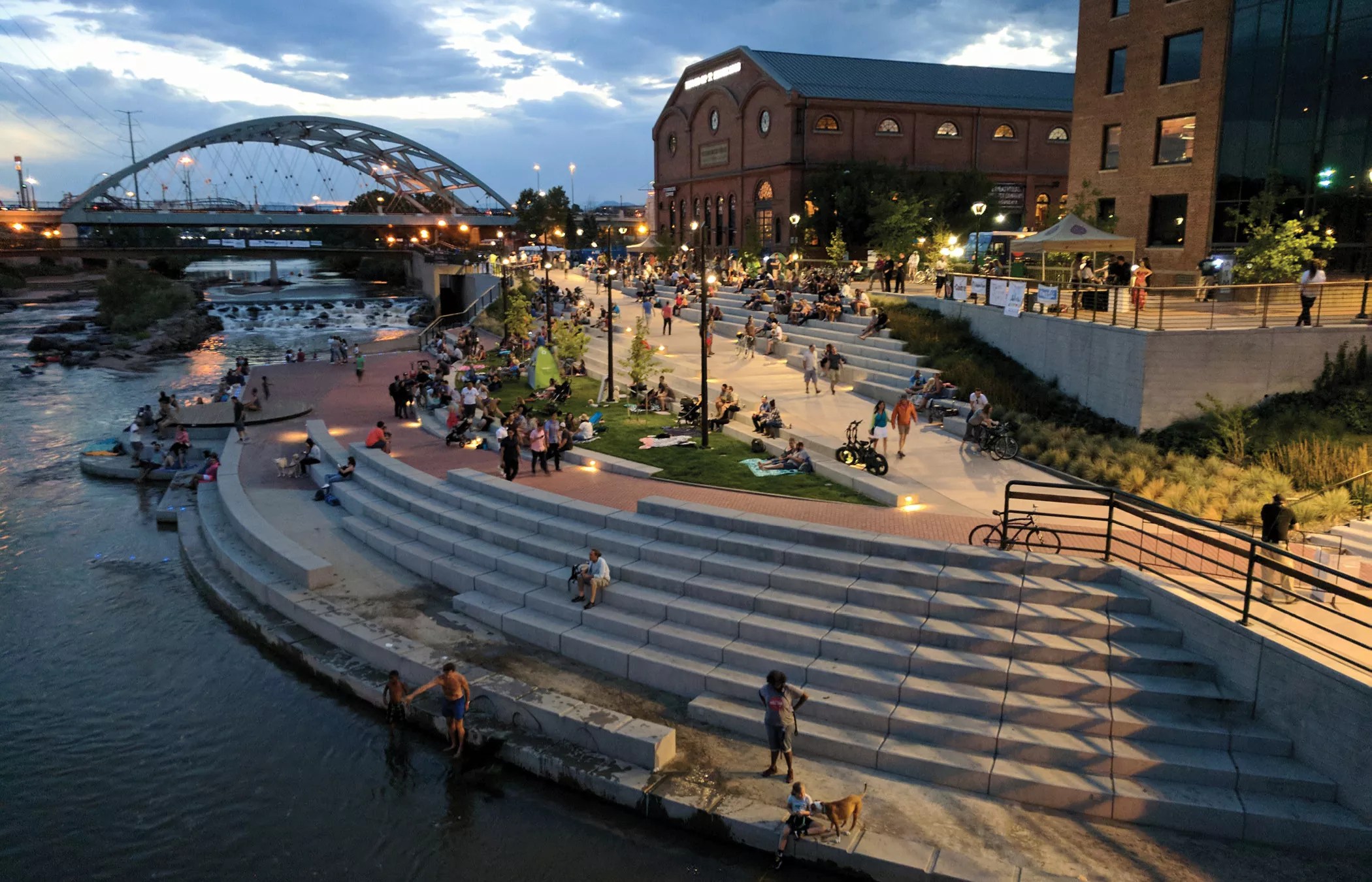
Confluence Park will be redesigned for the River Mile project.
Brad Nicol Photography for Wenk Associates
The loss of the current, iconic Confluence Park design is very much on his mind as he looks to the future. “We want to be able to go back to people who ask ‘What did we trade for?’ with some good answers,” he says. “One thing we’re trading for is a safer river: There will be less flood risk for people and their homes.
The other is that it’s a natural restoration, and we’re creating recreation within that natural restoration.
When people look at it and say, ‘Boy, Confluence Park is gone now,’ just know that Confluence Park was built with a twelve-foot-high existing dam across the river. What we’ll be getting is getting riparian species back, getting the river right-sized in its base so it’s not overheating, moving sediment through so it’s not building up and flooding our city. And we’re creating people access. So you’re really getting a lot at the River Mile for this exchange, and what you’re losing is this artificial construct at Confluence Park.”
Shoemaker, who has spent most of his career shepherding projects on the South Platte, calls the River Mile “the largest transformational change of the river ever.” He would know: As a Republican state senator from 1962 to 1976, his late father, Joe Shoemaker, drafted and shaped legislation to create the Urban Drainage & Flood Control District and clean up the South Platte. He also founded the Greenway Foundation, kickstarting and overseeing what is widely regarded as one of the country’s most successful river reclamation projects. Shoemaker Plaza at Confluence Park was named for Joe Shoemaker.
But now, Jeff Shoemaker acknowledges, “it’s all going to change.” The river rehabilitation work that will create the River Mile will drop the river by nine feet, narrow it, increase its grade to help with silt buildup in the water, and help give shape to a new urban neighborhood in Denver on one of the last available sites for such a development. “It’s a river that deserves it,” he says.
While the River Mile is the highest-profile project on the CRSA’s radar, Riordon thinks the potential for river surfing is limitless, and suggests that there might be appropriate sites for dozens of other waves on Colorado rivers.
“Every state in the United States has hundreds of low-head dams that are dangerous and need to be mitigated with a boat chute or removed completely, to make it safe for individuals, safe for the environment, and safe for property,” he says. “Any low-head dam mitigation project leads to an opportunity to create water parks that are surfable, with waves purpose-built for river surfing.”
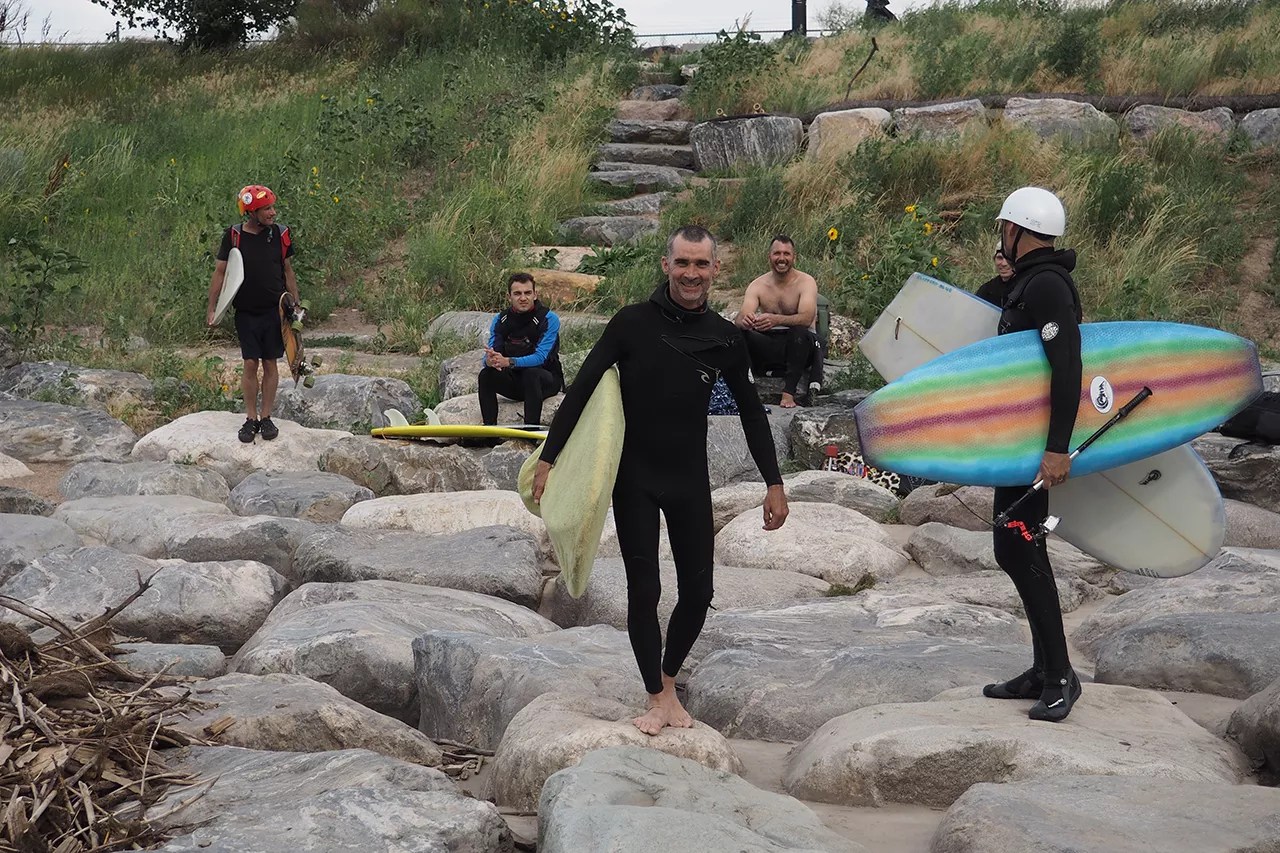
A group of surfers at River Run Park.
Jay Vollmar
The American Society of Civil Engineers defines a low-head dam as “a manufactured structure, built in a river stream or stream channel, extending fully across the banks, designed and built such that water flows continuously over the crest from bank to bank. If water levels rise downstream, a submerged hydraulic jump can form which produces an upstream directed current that traps any recreationist who might go over the dam.”
Low-head dams are also colloquially known as drowning machines: Riordon notes that 111 deaths attributed to low-head dam incidents were recorded nationally between 2018 and 2020.
As we wait for the afternoon flow to increase at Dave’s Wave, keeping an eye on markings on the rocks near the opening of the boat shoot that help indicate the water level, he offers a history lesson.
“This country has historically used water power to move the wheels that turn the gins and mills, and rivers have always been a flowing source of energy as well as a source of water,” he begins. “Since the early 1800s, the rivers have been dammed with these low-head dams, from a couple feet high to ten feet high or even higher, and it diverts the water, whether to move a wheel to power the mill or to put the water into a farmer’s land. The problem with a low-head dam straight across the water is it raises the water, and the dam itself creates a process where the water spills over and hits the slower water behind it, and it stands up and crashes on itself. That area – we call it the boil – becomes a spot where you can easily drown, and hundreds of people have drowned since they started recording low-head dam deaths.”
Riordon has found personal purpose in proposing an elegant solution.
“We know that you can mitigate that risk by cutting a boat chute through the center of the low-head dam,” he begins. “The boat chute creates a passage through that danger zone for boaters, people who use the water recreationally, fishermen, fish, or people or animals who fell in the river for whatever reason. You can also mitigate a low-head dam with a hydro jump that purposefully stands up a wave that is surfable.
That’s what we have at River Run Park, and it’s what I think we should have across Colorado and all over the world, anywhere it makes sense to create a recreational playground as cities and municipalities are doing the work to mitigate these low-head dams.”
In the Denver area alone, Riordon has identified several locations where dangerous low-head dams exist in spots that could become perfect playgrounds.
“Not every low-head dam needs to have a surfable wave, but I think every low-head dam that’s no longer needed for a purpose needs to come down,” he says. “If a low-head dam has to divert water for a purpose – for farming or whatever – we embrace that, but it has to be mitigated so it’s safe to get over.
And my argument is, if we’re going to have to do that mitigation anyway, let’s go ahead and make a bunch of them surfable, whether for kayakers or standup paddlers or for ocean-style surfers like us. As we’re reclaiming these rivers, we’re realizing the recreational possibilities.”
“As we’re reclaiming these rivers, we’re realizing the recreational possibilities.”
At Dave’s Wave, authorities were initially surprised to see surfers riding the small wave after a boat chute was installed by the Army Corps of Engineers, partly because the spot is downstream from a water-treatment plant.
“The treatment plant puts about 24 million gallons of cleaned effluent into the river daily, and that’s why there’s consistent afternoon water flow here,” Riordon explains. He and other CRSA members toured the water-treatment facility to learn more about the water in which they were surfing. “They assured us the water is safe – it meets EPA standards. They’ve even made beer out of that water.”
The low-head dam at Dave’s Wave is designed to aerate the water, adding oxygen to what’s coming out of the treatment facility to make it healthier for fish and other animals.
“When they mitigated this dam with a boat chute, lo and behold, they didn’t realize it, but they actually built a surfable wave,” Riordon notes. “It’s a small wave, but it’s surfable close to 365 days a year.”
The spot is named after Dave Schaumbach, who had the Thornton police called on him after he discovered he could ride it. The CRSA has since adopted the stretch of greenway on the west side of the river near Dave’s Wave, and members get together for litter pick-up days there several times a year. It has also become a tradition for the local river-surfing community to don full wetsuits and surf the wave together at Thanksgiving and on Boxing Day. Riordon says he has surfed Dave’s Wave when there was snow on the ground and air temperatures were as low as 15 degrees.
He acknowledges he might be a little bit crazy.
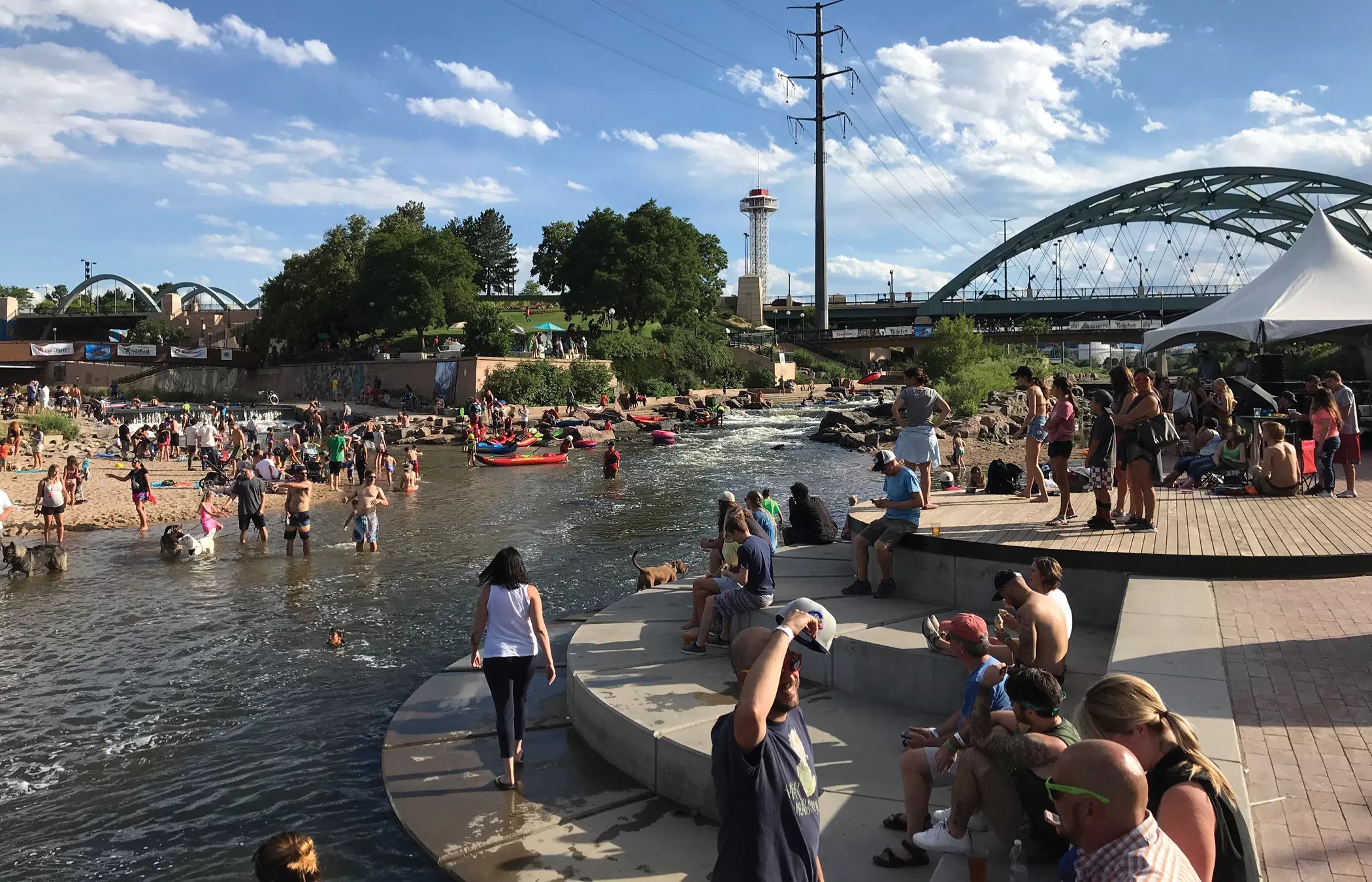
Confluence Park is a city playground.
Brad Nicol Photography for Wenk Associates
River surfing didn’t start in Colorado, and Denver isn’t the first urban spot to see surfers in its rivers. To the best of Riordon’s knowledge, the sport started on the Eisbach River in Munich, Germany, where surfers have been converging on the city’s famed Englischer Garden near the Haus der Kunst art museum since a wave appeared there in 1972. “Eisbach was a happy accident the locals helped improve over the years with unapproved modifications,” Riordon says. “We’re lucky here in Colorado to have some very inspired engineers designing features that help create ideal surfing conditions.”
Learning to understand that river-surf waves can be incorporated into those larger projects has helped guide the CRSA’s mission.
“The cool thing about these projects is that the river waves aren’t the focus,” Riordon says. “The main focus is threefold. First, you want to make sure you mitigate so it’s safe for people and protects property.
When you look at a project like River Run Park, that part of the river had been left to fester, and it was becoming increasingly dangerous: It had rocks that had been undercut by the water, strainers where trees had grown into the water, some potential death traps. So they had to fix that. The second piece is to protect the environment, to make it more of an environmentally friendly river. The South Platte is never going to be the same river it was back when only Native Americans lived here, when it was only a couple inches deep and a mile wide. We won’t ever have that again. But the next best thing is to make it so it’s livable for fish and for wildlife.
“And then the third focus is the recreation side: That’s where the river waves come in – not only for river surfing, but for people going through with kayaks and boats and on tubes. By adding boat chutes and artificial waves, they’ve made it safer to play in the water,” he adds.
They’ve also made it more popular.
“Ocean-style surfing on rivers is really growing into its own thing.”
“Ocean-style surfing on rivers is really growing into its own thing,” Riordon says. “I think the story here is that we have a growing and vibrant community that is diverse, environmentally conscious and deeply involved in seeing our river waterways become safer and more beautiful while creating new river playgrounds. And we’re also deeply involved in passing that down to the next generation.”
Riordon points to Littleton High School’s new River Surfing Club as a producer of future champions of Colorado’s rivers. A longtime volunteer in the Denver chapter of the Chill Foundation’s snowboarding program, he’s also been working to help CRSA connect with those same young people.
“The Chill Foundation is a nonprofit started by Donna Carpenter and her late husband, Jake Burton Carpenter, to take underserved youth up to the mountains and teach them how to snowboard, and we’ve partnered with them and the Colorado River Surf School to teach river surfing to those same youth,” he explains. “We tell the Chill kids the same thing we tell any new surfer who shows up and wants to try it: Sit back and watch what the locals are doing first. Get educated about river safety, and some of the inherent risks, and the mechanics of low-head dams and how these waves work. Wherever there are surfers, there are people who will help you figure out how to get into the waves safely.”
Information sources like EndlessWaves.net and ColoradoRiverSurfing.org will provide more advice, as will local retailers Confluence Kayaks and Altitude Paddleboards.
Max Campbell, the river-surfing expert at Confluence Kayaks, says the sport has taken off so fast that the store has had problems keeping gear in stock, especially in the midst of the pandemic. He’s proud to carry river surfboards and quick-release leashes from three Colorado companies that have been driving progression in river surfing: Badfish in Salida, SOL Paddleboards in Telluride, and Hala Gear in Steamboat Springs.
“In the last five years, we’ve been selling a lot of the shorter, foam, soft-top boards built for the man-made waves,” Campbell says. “Those are the most affordable and the easiest to get out there, and they’re perfect for a beginner progression from boogie boarding the wave on your stomach to moving your way to standing up. The seasoned surfers out there tend to like the composite boards: they’re a lot stiffer and offer a lot more control. I always recommend a helmet and personal flotation device – I’m out there all the time and I’m always wearing those – and I also recommend some kind of river footwear, just because you will be swimming and then you’re going to be walking on the rocks.”
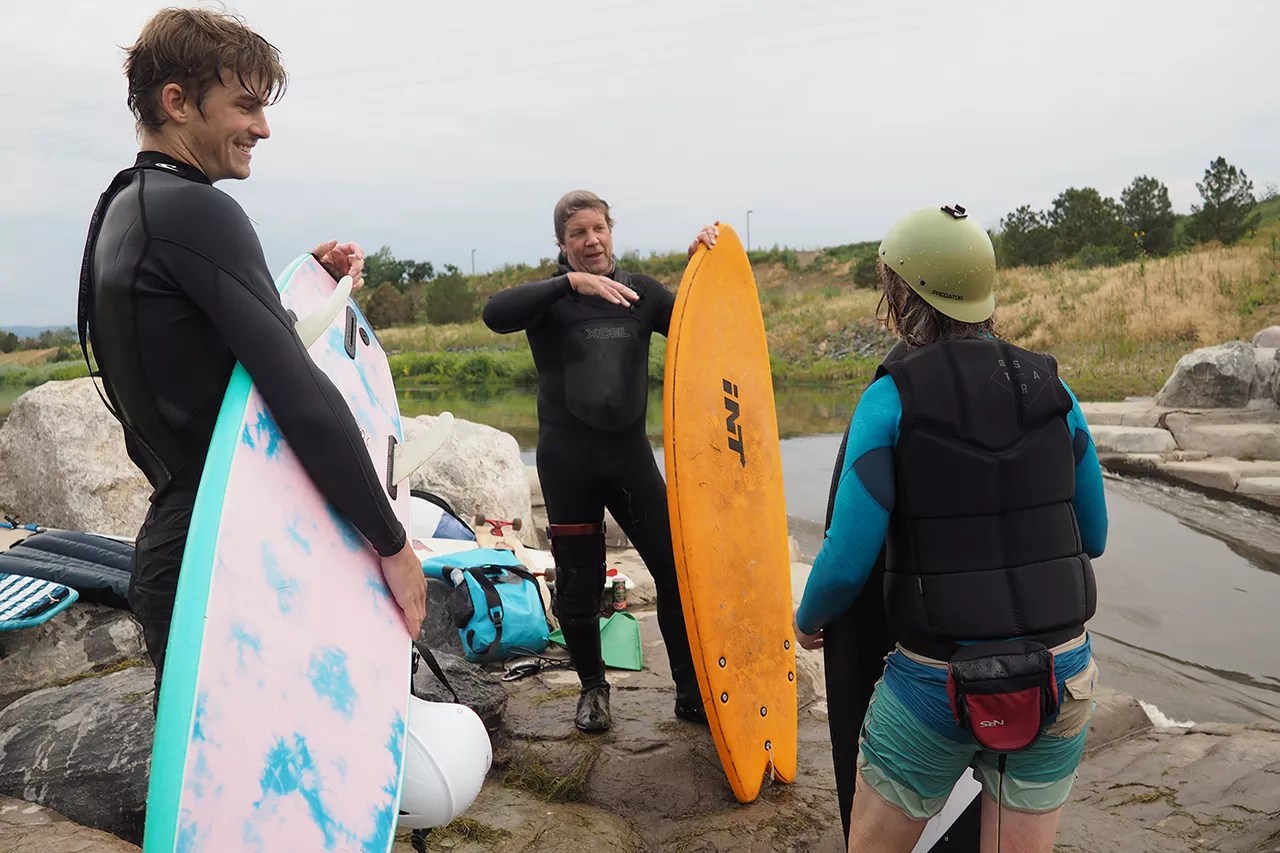
George Da-Grom (left), Colorado River Surfing Association president David Riordon and Dan Vandenberg.
Jay Vollmar
Near the end of my second day of trying, after a long chat with Riordon about river surfing’s history and future in Colorado, I finally start to get the hang of it, rising to my feet at Dave’s Wave and carving some proper turns. Riordon is the only one there to see it, and he’s as ecstatic as I am.
On the spot, I start making plans to get my own gear lined up in time for next summer.
“Surfing a wave is one of the best feelings there is,” Riordon says, clapping me on the back after my brief but thrilling ride. “Everyone I’ve ever helped get up on a wave has fallen in love with that sensation.”